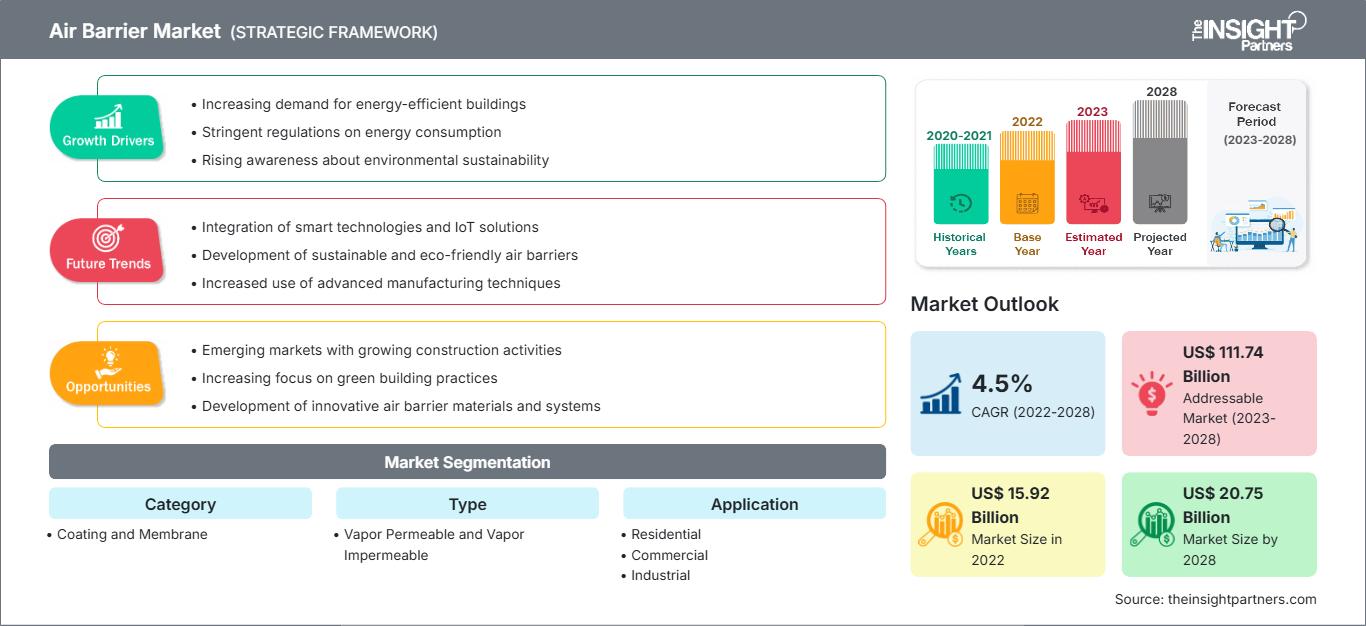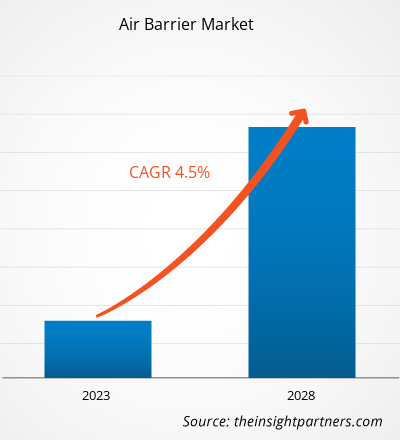[Rapport de recherche] Le marché des pare-air était évalué à 15 924,68 millions de dollars américains en 2022 ; il devrait croître à un TCAC de 4,5 % entre 2022 et 2028.
Un pare-air est un matériau utilisé pour contrôler le flux d'air dans les enveloppes de bâtiments. Ces systèmes enferment complètement l'air à l'intérieur d'un bâtiment. Les propriétés physiques qui distinguent les pare-air des autres matériaux sont leur capacité à résister au flux d'air et à la pression. Les pare-air peuvent être situés n'importe où dans l'enveloppe du bâtiment, à l'extérieur, à l'intérieur ou à n'importe quel endroit intermédiaire. Dans les climats chauds, les barrières d'air intérieures aident à contrôler l'exfiltration de l'air intérieur, tandis que les barrières d'air extérieures contrôlent l'infiltration de l'air extérieur et empêchent le passage du vent à travers l'isolation.
Impact de la pandémie de COVID-19 sur le marché des barrières d'air
Avant la pandémie de COVID-19, le marché mondial des barrières d'air était principalement stimulé par leur utilisation croissante dans les secteurs de la construction résidentielle, commerciale et industrielle. Cependant, en 2020, diverses industries ont dû ralentir leurs activités en raison des perturbations des chaînes de valeur causées par la fermeture des frontières nationales et internationales. La pandémie de COVID-19 a eu des répercussions négatives sur les économies et les industries en raison des confinements, des interdictions de voyager et des fermetures d'entreprises. Elle a provoqué des perturbations de la chaîne d'approvisionnement en matières premières essentielles et a entravé les processus de fabrication en raison des restrictions imposées par les autorités gouvernementales. La pandémie de COVID-19 a eu des répercussions sans précédent sur le secteur de la construction, impactant négativement la croissance du marché des barrières d'air. De plus, les matériaux nécessaires au secteur de la construction ont vu leurs prix augmenter en raison des perturbations de la chaîne d'approvisionnement, de la hausse des coûts de main-d'œuvre et de la forte demande.
Cependant, le marché se redresse grâce aux mesures importantes prises par les gouvernements de différents pays. Le secteur de la construction doit également surmonter les difficultés liées aux perturbations de la chaîne d'approvisionnement en matières premières. La reprise des activités de construction à l'échelle mondiale a créé une demande de barrières d'air.
Personnalisez ce rapport en fonction de vos besoins
Vous bénéficierez d’une personnalisation sur n’importe quel rapport - gratuitement - y compris des parties de ce rapport, ou une analyse au niveau du pays, un pack de données Excel, ainsi que de profiter d’offres exceptionnelles et de réductions pour les start-ups et les universités
Marché des barrières à air: Perspectives stratégiques

-
Obtenez les principales tendances clés du marché de ce rapport.Cet échantillon GRATUIT comprendra une analyse de données, allant des tendances du marché aux estimations et prévisions.
Aperçu du marché
Divers avantages des pare-air
Les systèmes de pare-air aident à prévenir les pertes d'air conditionné. Ils contribuent également à empêcher la pénétration de polluants tels que les particules en suspension, la poussière, les allergènes, les insectes, les odeurs et le bruit. La moisissure est fréquente dans les bâtiments où l'air humide s'accumule sur les composants muraux vulnérables, notamment l'isolant, le revêtement extérieur ou les panneaux muraux intérieurs. Cela peut nuire à la qualité de l'air intérieur et à la santé des occupants. De plus, les pare-air contribuent aux économies d'énergie. Ces économies peuvent se traduire par des économies de coûts importantes. De plus, les pare-air peuvent augmenter la valeur des bâtiments commerciaux en réduisant les coûts d'exploitation. Par conséquent, les divers avantages des pare-air se traduisent par une adoption accrue dans les secteurs résidentiel, commercial et industriel, stimulant ainsi leur marché.
Aperçu des catégories
Le marché des pare-air est segmenté en revêtements et membranes par catégorie. Le segment des revêtements a représenté une part importante du marché des pare-air en 2021. Le revêtement pare-air est pulvérisé ou appliqué au rouleau sur le support mural. Il permet de réduire les coûts de main-d'œuvre lors de l'installation. Les pare-air sont faciles à utiliser pour les substrats complexes. Ils adhèrent efficacement et assurent l'étanchéité de divers types de murs.
Informations sur les types
Selon le type, le marché des pare-air est segmenté en deux catégories : perméables à la vapeur et imperméables à la vapeur. Le segment imperméable à la vapeur a représenté une part importante du marché des pare-air en 2021. Les pare-air imperméables à la vapeur sont conçus pour bloquer la vapeur d'eau et l'air tout en empêchant pratiquement toute pénétration de vapeur d'eau à travers le matériau. Ces facteurs essentiels alimentent la demande de barrières d'air imperméables à la vapeur.
Les principaux acteurs du marché sont : BASF SE, Dow Inc, 3M, WR Meadows Inc, GCP Applied Technologies Inc, CertainTeed LLC, Tamarack Materials Inc, VaproShield LLC, TK Products Construction Coating, Henry Co, Carlisle Companies Inc et General Electric Co. Ils se concentrent sur la fourniture de produits de haute qualité pour répondre à la demande des clients. Ils privilégient également des stratégies telles que les investissements dans la recherche et le développement et le lancement de nouveaux produits.
Marché des barrières à air
Les tendances régionales et les facteurs influençant le marché des barrières à air tout au long de la période de prévision ont été analysés en détail par les analystes de The Insight Partners. Cette section aborde également les segments et la répartition géographique du marché des barrières à air en Amérique du Nord, en Europe, en Asie-Pacifique, au Moyen-Orient et en Afrique, ainsi qu'en Amérique du Sud et en Amérique centrale.Portée du rapport sur le marché des barrières à air| Attribut de rapport | Détails |
|---|---|
| Taille du marché en 2022 | US$ 15.92 Billion |
| Taille du marché par 2028 | US$ 20.75 Billion |
| TCAC mondial (2022 - 2028) | 4.5% |
| Données historiques | 2020-2021 |
| Période de prévision | 2023-2028 |
| Segments couverts |
By Catégorie
|
| Régions et pays couverts |
Amérique du Nord
|
| Leaders du marché et profils d'entreprises clés |
|
Densité des acteurs du marché des barrières à air : comprendre son impact sur la dynamique des entreprises
Le marché des barrières à air connaît une croissance rapide, portée par une demande croissante des utilisateurs finaux, due à des facteurs tels que l'évolution des préférences des consommateurs, les avancées technologiques et une meilleure connaissance des avantages du produit. Face à cette demande croissante, les entreprises élargissent leur offre, innovent pour répondre aux besoins des consommateurs et capitalisent sur les nouvelles tendances, ce qui alimente la croissance du marché.
- Obtenez le Marché des barrières à air Aperçu des principaux acteurs clés
- Tendances progressives de l'industrie sur le marché des barrières à air pour aider les acteurs à développer des stratégies efficaces à long terme
- Stratégies de croissance des entreprises adoptées par les marchés développés et en développement
- Analyse quantitative du marché des barrières à air de 2020 à 2028
- Estimation de la demande de barrières à air
- Analyse PEST pour illustrer l'efficacité des acheteurs et des fournisseurs opérant dans l'industrie
- Développements récents pour comprendre le scénario de marché concurrentiel
- Tendances et perspectives du marché, ainsi que facteurs qui stimulent et freinent la croissance du marché des barrières à air
- Aide au processus de prise de décision en mettant en évidence les stratégies de marché qui sous-tendent l'intérêt commercial, conduisant à la croissance du marché
- Taille du marché des barrières à air à différents nœuds
- Aperçu détaillé et segmentation du marché, et des produits chimiques et Dynamique de l'industrie des matériaux
- Taille du marché des pare-air dans diverses régions avec des opportunités de croissance prometteuses
Par catégorie, le marché des pare-air est segmenté en revêtements et membranes. Par type, le marché est segmenté en perméables à la vapeur et imperméables à la vapeur. Par application, le marché est segmenté en résidentiel, commercial et industriel.
Profils d'entreprise
- BASF SE
- Dow Inc
- 3M
- WR Meadows Inc
- GCP Applied Technologies Inc
- CertainTeed LLC
- Tamarack Materials Inc
- VaproShield LLC
- TK Products Construction Coating
- Henry Co
- Carlisle Companies Inc
- General Electric Co.
- Analyse historique (2 ans), année de base, prévision (7 ans) avec TCAC
- Analyse PEST et SWOT
- Taille du marché Valeur / Volume - Mondial, Régional, Pays
- Industrie et paysage concurrentiel
- Ensemble de données Excel
Rapports récents
Témoignages
Raison d'acheter
- Prise de décision éclairée
- Compréhension de la dynamique du marché
- Analyse concurrentielle
- Connaissances clients
- Prévisions de marché
- Atténuation des risques
- Planification stratégique
- Justification des investissements
- Identification des marchés émergents
- Amélioration des stratégies marketing
- Amélioration de l'efficacité opérationnelle
- Alignement sur les tendances réglementaires






















 Obtenez un échantillon gratuit pour - Marché des barrières à air
Obtenez un échantillon gratuit pour - Marché des barrières à air